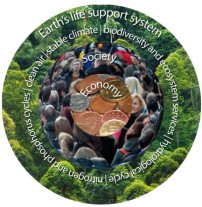
Biodiversity is the world’s natural wealth. Our social and economic well-being and our futures depend on it. In 2010, the 193 member states of the Convention on Biological Diversity adopted a new Strategic Plan for Biodiversity for the years 2011–2020, with 20 Aichi Biodiversity Targets. BirdLife International’s own Strategic Plan aims to make a real contribution to achieving global targets for biodiversity and sustainable development. As civil society organisations, working with governments, communities and across sectors and country borders, BirdLife Partners can play a key role in the concerted action that will be needed.

Biodiversity—the variability among living things and ecological systems—is the world’s natural wealth and a vital part of Earth’s life support system. Our social and economic well-being and our futures depend on it. Biodiversity provides us with vital goods and services and maintains the life-sustaining systems of the biosphere. It is a genetic storehouse, a treasure-trove of future medicines and materials, and also amazingly complex and beautiful. Yet biodiversity is being lost faster than ever.
The immense economic importance of biodiversity has already been highlighted by the Economics of Ecosystem Services and Biodiversity project (TEEB). In 2010, the 193 member states of the Convention on Biological Diversity adopted a comprehensive and ambitious new Strategic Plan for Biodiversity for the years 2011–2020, with 20 Aichi Biodiversity Targets. In 2011, governments agreed to set up an Integrated Science-Policy Platform on Biodiversity and Ecosystem Services (IPBES) to bring sound science to bear effectively on decision-making.
At the Rio+20 summit in June 2012, world leaders set in motion the development of new Sustainable Development Goals. It is vital that these goals fully recognise the role of biodiversity in ensuring a viable future for humanity.
BirdLife International’s own Strategic Plan aims to make a real contribution to achieving global targets for biodiversity and sustainable development. As civil society organisations, working with governments, communities and across sectors and country borders, BirdLife Partners can play a key role in the concerted action that will be needed.
Through its strategic objectives, BirdLife aims to:
SAVE SPECIES by conserving and restoring species populations across their natural ranges, and maintaining genetic diversity, ensuring they can continue to play their role in the web of life and for the enjoyment and benefit of future generations
CONSERVE SITES AND HABITATS by ensuring effective conservation, through action and advocacy, of the most important sites and habitats for nature across the world
ENCOURAGE ECOLOGICAL SUSTAINABILITY by promoting sustainable management of our planet and its natural resources so as to secure a future for birds, biodiversity, and ourselves
EMPOWER PEOPLE for positive change by restoring or strengthening the connections between people and nature, building and consolidating a movement of local and national civil-society conservation organisations that can provide broad-based support for nature conservation.
The BirdLife Strategy is translated into action through a set of BirdLife Global and Region-specific Conservation Programmes. Nine Global Conservation Programmes are already in place for the planning period 2013–2020, as follows: Preventing Extinctions; Important Bird and Biodiversity Areas; Migratory Birds and Flyways; Seabirds and Marine Conservation; Forests of Hope; Climate Change; Invasive Alien Species; Local Empowerment; and Capacity Development.
Links
Compiled: 2004 Last updated: 2013
Recommended Citation:
BirdLife International (2013)
Sustainable development relies on biodiversity conservation.
Downloaded from https://datazone.birdlife.org/sowb/casestudy/sustainable-development-relies-on-biodiversity-conservation on 23/12/2024